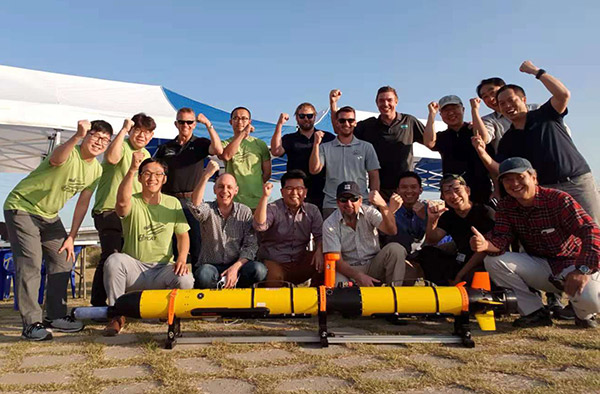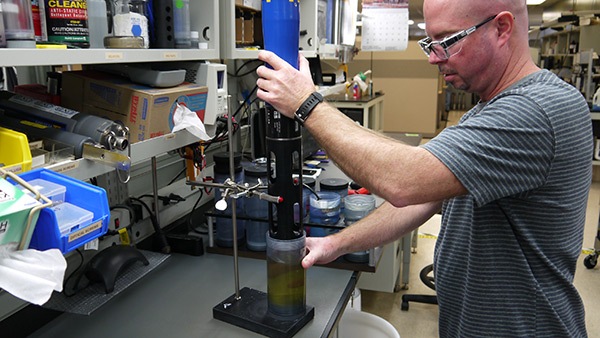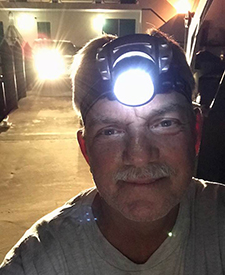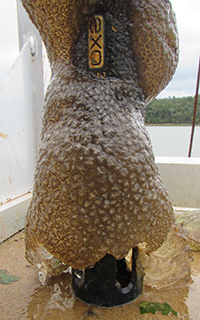The Most Important New Year’s Resolution a YSI Customer Can Make
(Updated November 2021)
Welcome to a new year!!! This is the time of year where my social media accounts are flooded with promotions presuming that my New Year’s resolution is to “lose weight and feel great!” Surely a middle-aged, female, Facebook-dwelling, hound dog-posting American Midwesterner needs that!

Nah, I’m good.
Rather, I want to make a resolution that
- I might actually keep, and
- I can get some support with if I need it, because we all know how resolutions go.
If you are a YSI customer, I have just such a New Year’s Resolution for you:
Sounds simple, because it is!
If you follow us on social media you know that we regularly hear from customers with sondes that have been washed away by floods, banged around in hurricanes, invaded by tube worms, or colonized by barnacles and bryophytes, yet they still work even when recovered weeks or months after a natural disaster. We even have a customer who dragged their YSI Pro Series instrument down a gravel road for a few miles and it still worked! (Learn more, Rugged, Field-Proven Water Quality Meters | 3 Real Life Examples).
In other words, neither Mother Nature nor an occasional mishap is the biggest offender when it comes to shortening the lifetime of a water quality instrument. YSI designed the instruments to withstand these types of insults.
Rather, the most likely limitation on any instrument’s lifespan is whether it has been properly used and maintained.
We train customers all over the world in best practices for the use and maintenance of YSI instruments. It’s not always easy to convey these principles through manuals and handbooks, and there are tricks of the trade that even we have learned with time, sometimes from you, our customers! A lot of those things just don’t make it into manuals, and even if they did, would you read them anyway?
Just like us, I find that even the most experienced users can always learn something new that will help them take better care of their instruments, whether it’s a ProPlus, a ProDSS, or an EXO sonde. Thus, to start this year, I wanted to provide readers with a list of things you can do to take better care of any YSI instrument, protecting your investment for years to come. These are general recommendations; use them to drill down to more specific practices for your instruments and projects.
Build Your Relationship with YSI
We did a survey a few years ago to learn what our customers liked best about our instruments, and where there was room for improvement. Obviously, I expected to hear a lot of highly technical feedback, but interestingly what people liked best about our instruments really didn’t have anything to do with the instruments at all.
Rather, the overwhelming, resounding feedback was that YSI provides the best customer service in the water quality monitoring industry.
Are you taking advantage of YSI’s commitment to customer service? If you’re not, here are some ways that you can.
For starters, the person that sold that instrument to you isn’t a salesperson, though we refer to them as a “sales rep,” even in this article. In reality, he or she typically has a science or engineering degree, years of experience working either for us or a scientific organization and an excellent command of any instrument they might show you.
These individuals are your most important contact not just at the point of sale, when they can provide anything from demos to sole source justifications, but also throughout the lifetime of your instrument and beyond when you’re ready to upgrade. They don’t go away just because we got your money. If they can’t help you, they know how to put you in touch with the people who can, and they are also an important point of contact for your feedback.

What if you bought your instrument years ago from a person that is no longer at YSI, or whose name you don’t remember? What if you made your purchase on ecommerce? No problem! You can contact us at +1 (937) 688-4255 or visit the Customer Support page to get the name and email of someone who can follow up with you. You can also Ask a Question with our online form. Alternatively, especially if you are an ecommerce customer, you can contact our world-class technical support team at info@ysi.com, or even use our awesome online chat feature to get help right at your fingertips. We also have a lot of recorded webinars and how-to videos including educational courses for some of our products on our Video Hub.

There are other reasons to engage with these “first responders” that might not be readily apparent. Not only might they help you troubleshoot issues, but also they receive more general feedback, including complaints. This team is an important conduit to people like me, known as product managers, who share responsibility for the development of new products, improvements to old products, and troubleshooting issues like delivery times with our operations team. Product managers don’t face the customer nearly as often as we would like, and front-line feedback coming through the folks that face the customers every day is one of the best ways information reaches us, enabling you to influence the future of YSI’s products.
Another thing this team can often do is put you in touch with other customers who might be doing work similar to yours. There is a YSI community out there, and you can engage that community by asking us for references or even directly through our social media sites or you can connect with me on Twitter @WaterWoman.
Finally, we often schedule on-site training events that are focused on a particular topic (e.g., sonde  maintenance, autonomous vehicles, or harmful algal blooms). Workshops are free, tailored to your specific interests, sometimes offer continuing education credits, and usually involve an audience of 30-50 people. Not only are workshops great learning events, but they are invaluable networking opportunities and will help you get to know your YSI team better.
maintenance, autonomous vehicles, or harmful algal blooms). Workshops are free, tailored to your specific interests, sometimes offer continuing education credits, and usually involve an audience of 30-50 people. Not only are workshops great learning events, but they are invaluable networking opportunities and will help you get to know your YSI team better.
Presentations are not sales pitches, but rather involve both YSI experts (such as Application Specialist Curtis Butler, shown at right, getting ready for a night time visit) and customers who can share non-commercial, on-the-ground perspectives. The person who sold you your equipment is your best contact if you’re interested in arranging such an event, or contact YSI Technical support if you’d like to learn more information (+1 (937) 688-4255 or info@ysi.com).
Workshops bring me to another way in which you can fulfill your New Year’s Resolution: make a renewed commitment to training.
Train Yourself, Train Your Team
Many of YSI’s instruments are very easy to use, and that’s why they are available on ecommerce. The Pro20i is a great example. However, instruments like the ProDSS might not be as straightforward, and even though you can purchase it online, a direct purchase from a sales rep will ensure that you select the right instrument and also that you will receive the basic training on how to use the instrument when you receive it. This training, however, should be just the first step you take in educating yourself and other users about your instruments.
I’ll be the first to admit that user manuals are not an exciting reading experience, but the manual for your YSI instrument really is the most complete and accessible training resource you have. In fact, you should peruse the user’s manual before you purchase an instrument to make sure you have all the resources you need to take care of it. In spite of the importance of the user’s manual, however, it should not form the entirety of your training program. Rather….
Everyone should develop SOPs that are specific for their water quality monitoring program.
I advise that every program have SOPs (Standard Operating Procedures) that cover five basic areas:
- Calibration
- Use/deployment
- Cleaning
- Storage
- Safety
My colleague wrote up 5 Tips to Prevent Costly Mistakes with Your Water Quality Sonde, which has some very good advice related to calibration. The blog is a nice complement to the more specific calibration information found in the EXO User’s Manual. Similarly, our YSI Repair Center provided some tips on How to Take Care of Your New EXO Sonde. While both blogs talk about calibration, deployment, cleaning, and storage of EXO sondes, much of the advice can be applied to almost any YSI instrument! In addition, the YSI EXO University and YSI ProDSS University provide hours of training on these topics for free.
 So what should your program-specific SOPs contain that you cannot find in manuals and other resources? Again using EXO sondes as an example, the fouling that a sonde is subjected to can be very site-specific and should be addressed in program-specific SOPs. Fouling in the Gulf of Mexico is very different than fouling experienced at Lake Erie, and both are completely different than fouling experienced at an acid mine drainage site. Each of these scenarios will require different strategies and materials for deploying and cleaning the sonde. Once again, Lyndsey McDermand touched on this in a prior blog entitled “Fighting Fouling,” where Tip #6 was that you should consider your deployment location to come up with the right strategy to prevent and protect against fouling.
So what should your program-specific SOPs contain that you cannot find in manuals and other resources? Again using EXO sondes as an example, the fouling that a sonde is subjected to can be very site-specific and should be addressed in program-specific SOPs. Fouling in the Gulf of Mexico is very different than fouling experienced at Lake Erie, and both are completely different than fouling experienced at an acid mine drainage site. Each of these scenarios will require different strategies and materials for deploying and cleaning the sonde. Once again, Lyndsey McDermand touched on this in a prior blog entitled “Fighting Fouling,” where Tip #6 was that you should consider your deployment location to come up with the right strategy to prevent and protect against fouling.
As another example, your program might not have access to a lab. Without a facility-specific disposal process, are you going to have the right place to properly dispose of used calibration standards? For some sensors (e.g., total algae and rhodamine) you have to make your own calibration standards, and might need pipets or glassware that is not always found in some labs. Is there another way you can accomplish this? Speaking of the Total Algae sensors, I’ve learned that the rhodamine we recommend for calibration is not available around the globe. Your program-specific SOPs should identify acceptable sources of rhodamine and how that solution should be prepared for your purposes, which could be quite different than what we have in the EXO User’s Manual!
Finally, every program should commit to safety for both their personnel and their equipment. The safety guidelines in a user’s manual cannot cover things like a steep river bank, an icy dock, safe handling of acids or bases used in preparation of calibration standards, or all personal protective equipment (PPE) needed for your program. Please take the time to review your processes for safe handling and use of your YSI instruments!
Take Advantage of Maintenance/Service Plans
The long-term cost of ownership is significantly lower when one purchases the highest-quality instrumentation, and this principle is well understood by our enthusiastic and long-standing customer base. YSI water quality instruments are renowned for their ruggedness and long life relative to comparable products, and therefore the up-front cost, which I fully acknowledge is higher than most of our competitors’ prices, pays dividends in the long run. In other words, if you own a YSI instrument, it’s no secret that it didn’t come cheap, and depending on where you work it might not have come easy.
Thus our customers might want to take advantage of YSI programs that will lengthen the life and sustain the high performance of our instruments for as long as possible. Three examples are:
- The EXO Factory Service Plan,
- The ProDSS Factory Service Plan,
- The YSI Repair Center’s Winter Maintenance Specials.
The Factory Service Plans are relatively new (launched in late 2018), and were developed at the request of our customers. A three year Service Plan includes a number of maintenance and repair services, as well as replacement of some consumable items like pH modules and ODO caps.
A lot of North American customers have a water quality monitoring “season,” and use their instruments less from December through early Spring. To give their instruments a tune-up and prepare them for winter storage, many customers take advantage of the YSI Repair Center’s Winter Maintenance Specials that cover our multiparameter water quality monitoring instruments like the ProDSS, EXO sondes, and even the old 6-series sondes.
Note also that these programs also help you with the first two things discussed in this article. You will develop a relationship with the YSI service center that will be beneficial for the life of your sonde. Our technical team will know your instrument, will provide advice on how to best take care of it, and will be able to help you out in a pinch when you need it. You are also going to learn things that you wouldn’t by just reading the manual, possibly even things you’ll want to incorporate into your team’s practices and SOPs.
Recap: Specific Things You Can Do To Accomplish Your New Year’s Resolution!
To sum it all up, I hope that YSI customers will find something useful in this article to form the basis of a New Year’s resolution: take at least one step to take better care for your YSI instrument. It’s an important investment, and we want you to get the best data possible for that investment.
Above I provided some general advice towards that New Year’s resolution, and that advice fell into the following three areas:
- Build your relationship with YSI
- Train yourself, train your team
- Take advantage of Maintenance/Service Plans
In closing, here are five specific examples of things you might try to make sure you will accomplish your goals! Please visit me on twitter (@WaterWoman)—I would love to hear whether you take any of these steps or have any questions about your YSI instrument.
- Call or email your YSI sales rep—even if just to wish them a Happy New Year! They are always happy to hear from you and help you if they can.
- Identify one way in which you can do something more safely, and put it in an email to your team or incorporate it into an SOP.
- If your program doesn’t have any SOPs, write one! The hardest part is getting started, and there are a lot of SOP templates online to get you going. An SOP for proper calibration of a sensor is good place to start.
- If you already have SOPs, pick at least one for review/update.
- Ask a question—any question!—using the chat feature at ysi.com.

Additional Blog Posts of Interest
Three Wrong Assumptions About Water Quality Monitoring
5 Tips to Prevent Costly Mistakes with Your Water Quality Sonde
7 Tips to Fight Fouling and Extend Water Quality Sonde Deployments
Get Your Water Quality Sonde Ready for the Season